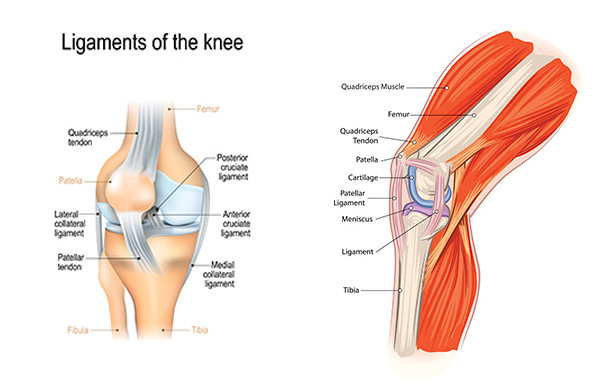Q: Is it always necessary to treat anterior cruciate ligament injury with surgery?
A: It is not always necessary to undergo surgery to treat a cruciate ligament injury. However, a torn anterior cruciate ligament cannot heal by itself. Therefore, even though patients with a torn anterior cruciate ligament injury may be able to carry out general everyday tasks, they should avoid playing sports that involve sudden movements as they risk dislocating their patella or developing other related knee injuries.
Q: What treatments are available for torn anterior cruciate ligaments injuries?
A: There are 2 main types of treatments available for torn anterior cruciate ligament injuries:
- Non-surgical treatments that are solely focused on relieving any pain and inflammation in the knee. This course of action is more suited to elderly patients who do not partake in physically demanding activities or play sports that involve sudden movements, changes of direction or heavy impacts. Doctors usually prescribe pain relief medication and anti-inflammatories. Once the symptoms have eased, the patient must carry out knee exercises to protect it from stiffness. Patients are also advised to strengthen the muscles surrounding the knee joint, including the quadriceps, hamstrings, hip flexors and core muscles, as this will help support the knee.
- Surgical treatments are suitable for younger patients who wish to make a return to the sport they love or perform other daily tasks that may require full use of their knees. Doctors often utilize arthroscopic surgery to restore as much stability as possible to the injured knee. This is often achieved by transplanting ligaments from other parts of the body to replace the injured knee ligament. The two sites most commonly harvested are the patellar region and the back of the knee. The benefit of arthroscopic surgery is speedy rehabilitation time, evidenced by the fact that patients often spend a mere 1-2 days recuperating in hospital before returning home.
Q: If I choose to undergo surgery for my injury, will I be able to make a return to playing sports?
A: Undergoing surgery alone is no guarantee that patients will be able to make a return to playing sports at the same level they did before. Patients who choose this form of treatment must also attend physiotherapy classes to strengthen their muscles, and they must complete exercises aimed at improving their balance and movement. They should also undergo coordination training, as this will give them the best chance of making a full return to the sports they love.
Q: How long will it take for me to be able to make a return to playing sports if I undergo anterior cruciate ligament surgery, followed by a full program of physiotherapy sessions?
A: It usually takes around 8-9 months of rehabilitation before a patient can return to playing sports.
Q: Will I have a problem with my knee in the future if I injure my anterior cruciate ligament but do not undergo any treatment or surgery?
A: Patients with a torn anterior cruciate ligament are at risk of dislocating the patella and experiencing early onset knee osteoarthritis. Patella dislocation is of particular concern due to the potential effects it can have on other parts of the knee joint, such as the cartilage, meniscus and other ligaments. However, the sole objective of surgery used to treat torn anterior cruciate ligaments is to stabilize the joint as much as possible in order to allow that person to return to playing sports. Currently, studies confirm that surgical treatment for torn anterior cruciate ligament injuries can play a part in protecting the patient against the early onset of knee osteoarthritis.
Q: What can I do to protect myself from sustaining sports-related knee injuries?
A: A muscular warm-up should be carried out prior to playing any sport as this will ensure the muscles are ready for the physical exertion that will follow. Nevertheless, another crucial aspect for athletes is stretching and strengthening those muscles, including quadriceps, hamstrings, hip flexors and core muscles. Moreover, exercises focused on improving balance and coordination, including both hand-eye and foot-eye coordination training, will go a long way toward reducing the chance of sustaining an injury while playing sports.
Playing sports is unarguably beneficial in many ways, as it can help strengthen the body. Even so, we should be careful when playing and ensure we use the correct techniques in order to protect ourselves against potential injuries. Furthermore, should you be unfortunate enough to sustain an injury, it is essential that you do not leave it untreated. Be sure to seek medical attention before the symptoms deteriorate or develop into a chronic health issue.
The Arthroscopic Surgery and Sports Orthopedic Center at Samitivej Hospital, Bangkok consists of an experienced team of medical professionals, specialized in all aspects of orthopedic surgeons, physical therapists and sports medicine doctors. These experts help rehabilitate the body, bones and joints to full fitness, so that all of our patients can enjoy the confidence that they are receiving the best treatments available and are able to return to their normal daily lives as quickly as possible.
Samitivej has a team ready to help and provide services for:
- Treatment Plan Consultation with a doctor via online video-call (second opinion)
- Treatment Planning if you have medical records or a price estimate from another hospital
- Cost Planning by our Appraisals Team with price guarantee (only for procedure packages without complications)
- Check Initial Coverage Eligibility with Thai and international insurance companies (only for insurance companies in contract with the Hospital)


